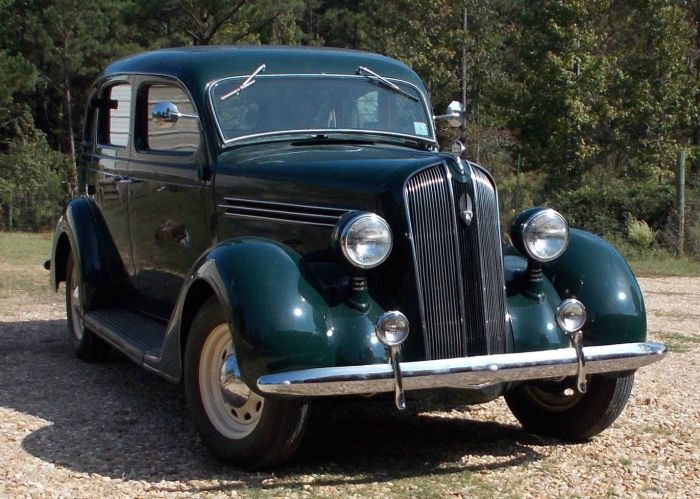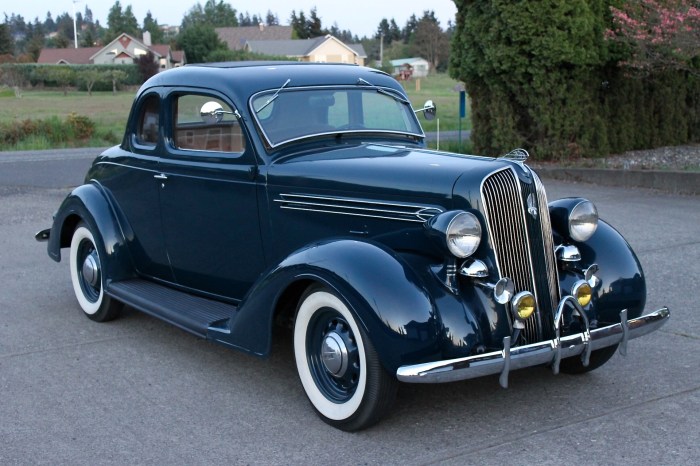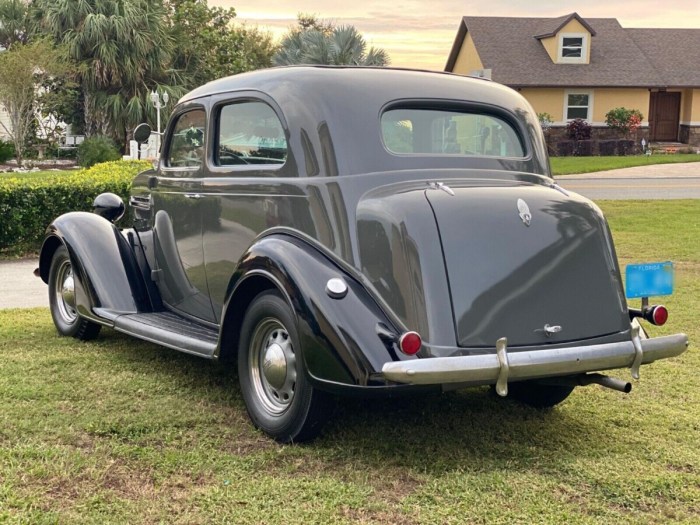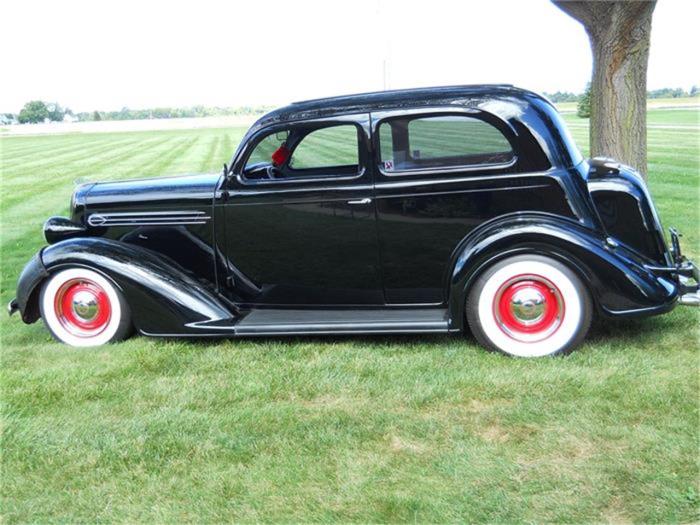The 1936 Plymouth P2, a symbol of American automotive ingenuity, emerged during a time of economic hardship and social change. Released in the midst of the Great Depression, the P2 offered a glimmer of hope for those seeking affordable and reliable transportation.
Its sleek design and advanced features for the era made it a popular choice for families and individuals alike, solidifying its place as a significant milestone in automotive history.
The P2 was a testament to Plymouth’s commitment to providing quality vehicles at an accessible price point. It featured a distinctive Art Deco aesthetic, with rounded curves and chrome accents that captured the spirit of the era. Under the hood, a powerful six-cylinder engine provided ample power for cruising down the open road.
The P2’s success helped to revive the American automotive industry and paved the way for future generations of Plymouth vehicles.
The 1936 Plymouth P2: A Turning Point in American Automotive History

The 1936 Plymouth P2 marked a pivotal moment in the history of the Plymouth brand and the American automotive industry as a whole. Released amidst the Great Depression, the P2 offered a compelling blend of affordability, style, and practicality that resonated with a nation seeking economic recovery and a renewed sense of optimism.
The 1936 Plymouth P2’s Place in the Automotive Landscape
The P2’s arrival coincided with a period of significant change in the automotive industry. The Great Depression had forced many manufacturers to scale back production and focus on creating more affordable vehicles. Plymouth, a relatively new brand launched by Chrysler in 1928, aimed to capitalize on this trend by offering a car that was both stylish and accessible to a wider audience.
The P2’s success helped solidify Plymouth’s position as a major player in the American automotive market.
Key Features and Innovations, 1936 Plymouth P2
The 1936 Plymouth P2 boasted several features that contributed to its popularity:
- Streamlined Design:The P2’s design, with its rounded bodywork and integrated fenders, exemplified the emerging trend towards aerodynamic styling. This not only improved the car’s appearance but also enhanced its fuel efficiency.
- Powerful Engine:The P2 was powered by a 196.3 cubic inch (3.2 L) inline six-cylinder engine that produced 68 horsepower. This engine provided ample power for both city driving and highway cruising.
- Affordable Price:The P2 was priced competitively, making it accessible to a wide range of buyers. This affordability was a key factor in its success during the Great Depression.
- Comfortable Interior:The P2’s interior featured comfortable seating and a range of convenience features, including a heater and a radio. These amenities made the car more appealing to families and individuals who wanted a comfortable driving experience.
The Impact of the 1936 Plymouth P2
The 1936 Plymouth P2 was a resounding success, selling over 200,000 units in its first year of production. This success helped to revitalize the Plymouth brand and establish it as a major player in the American automotive market. The P2’s popularity also had a broader impact on the industry, influencing the design and engineering of future cars.
Its streamlined styling and affordable price point helped to pave the way for the development of more accessible and stylish vehicles.
Design and Styling

The 1936 Plymouth P2, though modest in price, was a departure from the traditional boxy designs of the era. Its streamlined exterior and refined interior aimed to provide a more modern and comfortable driving experience.
Exterior Design Features
The Plymouth P2 featured a distinctive, aerodynamic design that was a significant departure from the boxy shapes of earlier models. Its rounded fenders, sloping hood, and integrated grille created a smooth, flowing profile. The car’s low-slung stance and wraparound windshield contributed to its modern look.
The 1936 Plymouth P2, a classic car with a distinct Art Deco design, was a far cry from the muscle car era of the 1970s. While the P2 was known for its affordability and practicality, the 1971 Plymouth Cuda embodied power and performance.
However, both cars share a legacy of innovation and a place in automotive history, showcasing the evolution of Plymouth through the decades.
Interior Design Elements and Comfort Features
The P2’s interior was designed with passenger comfort in mind. The spacious cabin offered ample legroom and headroom, even for taller individuals. The plush upholstery, available in a range of colors, enhanced the car’s overall appeal. The dashboard was streamlined and functional, with easy-to-read gauges and controls.
The P2 also offered optional features like a heater and a radio, adding to the comfort and convenience of the driving experience.
Comparison to Competitors
Compared to its competitors, the 1936 Plymouth P2 offered a unique blend of affordability, style, and comfort. While some rivals, like the Ford Model 8, boasted more powerful engines, the Plymouth’s sleek design and comfortable interior were notable advantages. The P2’s price point made it a compelling option for budget-conscious buyers who desired a modern and stylish car.
Technical Specifications

The 1936 Plymouth P2 was a significant advancement in automotive technology, boasting a number of innovative features and improvements that set it apart from its predecessors. The car’s technical specifications reflected the era’s shift towards greater efficiency, performance, and comfort.
Engine Performance and Fuel Efficiency
The 1936 Plymouth P2 was powered by a 196.3 cubic inch (3.2 L) straight-six engine, producing 82 horsepower. This engine was a significant upgrade from previous Plymouth models, offering more power and torque. The engine was paired with a single-barrel carburetor, which provided a balance of performance and fuel efficiency.
While the P2’s fuel efficiency figures are not readily available, contemporary reviews suggest that it offered respectable fuel economy for its time.
Transmission and Drivetrain
The 1936 Plymouth P2 was available with a three-speed manual transmission. The transmission was smooth and reliable, providing a good balance of performance and fuel efficiency. The P2’s drivetrain was a simple and robust design, featuring a solid rear axle and leaf springs.
Production and Sales: 1936 Plymouth P2
The 1936 Plymouth P2 was a significant success story for the Plymouth brand, and its production and sales figures reflect this. It was a popular choice among American car buyers, particularly those seeking a reliable and affordable vehicle.
Production Numbers and Sales Figures
The Plymouth P2 was produced in significant numbers, contributing to its success. Here’s a breakdown:
- Production:Over 250,000 units were manufactured during the 1936 model year. This was a remarkable achievement for Plymouth, surpassing its previous production records. The P2 was a major contributor to Plymouth’s overall sales success in 1936.
- Sales:The P2 was a hit with American consumers. It became one of the best-selling cars in the United States, capturing a considerable share of the market. The P2’s affordability and reliability were major selling points for consumers, leading to its popularity.
Target Market and Popularity
The 1936 Plymouth P2 was targeted towards a broad audience of American car buyers. Its affordability and practicality made it attractive to a wide range of consumers, including:
- Middle-Class Families:The P2 offered a reliable and affordable transportation option for families, making it a popular choice for middle-class households.
- Young Professionals:The P2’s stylish design and performance appealed to young professionals looking for a reliable and modern vehicle.
- Budget-Conscious Consumers:The P2 was priced competitively, making it an attractive option for consumers on a budget.
Factors Contributing to Success
Several factors contributed to the success of the 1936 Plymouth P2, including:
- Affordability:The P2 was priced significantly lower than many of its competitors, making it accessible to a broader range of consumers.
- Reliability:The P2 was known for its durability and reliability, offering peace of mind to its owners. Its simple design and robust construction contributed to its long-lasting performance.
- Stylish Design:The P2 featured a modern and stylish design that appealed to American consumers. Its streamlined bodywork and chrome accents gave it a distinctive look.
- Marketing and Advertising:Plymouth’s marketing and advertising campaigns effectively communicated the P2’s key selling points, including its affordability, reliability, and style.
Cultural Impact

The 1936 Plymouth P2, with its affordability and stylish design, resonated with the American public, becoming more than just a car. It represented a symbol of hope and prosperity during a time of economic hardship, reflecting the nation’s aspirations for a brighter future.
Its presence in popular culture further solidified its position as an icon of the era.
The 1936 Plymouth P2, a classic example of Art Deco design, marked a significant shift in the automotive landscape. While the P2 offered a more streamlined and modern aesthetic compared to its predecessors, it was a far cry from the rugged and versatile vehicles that would later emerge.
The 1978 Plymouth Trailduster , a true off-roader, epitomized the shift towards functional design, offering features like four-wheel drive and a spacious cargo area. Returning to the P2, its legacy lies not in its off-road capabilities but in its stylish design, a testament to the evolution of the automobile in the 20th century.
Appearances in Popular Culture
The 1936 Plymouth P2’s impact on popular culture is evident in its appearances in various forms of media, solidifying its place as a recognizable symbol of the era.
- Film:The car’s sleek design and affordability made it a popular choice for filmmakers. It appeared in numerous films of the era, often portraying the aspirations and struggles of ordinary Americans during the Great Depression. For example, the 1939 film “Mr.
Smith Goes to Washington” features a 1936 Plymouth P2 as the vehicle driven by the protagonist, Jimmy Stewart’s character, symbolizing his journey from small-town innocence to navigating the complexities of Washington politics.
- Television:The 1936 Plymouth P2’s enduring appeal is evident in its appearances on television shows that depict life in the 1930s and 1940s. For instance, the popular series “The Waltons” frequently features a 1936 Plymouth P2 as a symbol of the family’s resilience and determination during the Depression.
The car’s presence adds authenticity to the show’s depiction of life in rural America during that era.
- Literature:The car’s significance is not limited to visual media. It appears in various literary works, often serving as a symbol of the era’s social and economic conditions. For example, in John Steinbeck’s “The Grapes of Wrath,” the Joad family’s journey to California in search of a better life is depicted using a 1936 Plymouth P2, representing the family’s struggles and aspirations.
Reflection of Social and Economic Conditions
The 1936 Plymouth P2 served as a tangible representation of the social and economic conditions of the time.
- Affordability:The car’s affordability was a key factor in its widespread appeal. It provided a sense of mobility and freedom to those who had been financially impacted by the Great Depression. The P2’s lower price point, compared to other cars in the market, made it accessible to a wider range of consumers, offering a sense of hope and progress during a challenging period.
The 1936 Plymouth P2 was a significant model for the brand, showcasing a more streamlined design and advanced features. While the P2 was known for its sleek aesthetics, it was also influenced by earlier Plymouth models, like the 1929 Plymouth Coupe , which established the brand’s reputation for affordability and practicality.
The P2’s success solidified Plymouth’s position as a leading manufacturer in the American automotive landscape.
- Design:The car’s streamlined design, with its rounded fenders and flowing lines, reflected the optimism and modernism of the era. The P2’s design was a departure from the more traditional, boxy cars of the past, signifying a move towards a more streamlined and efficient future.
This aesthetic appeal resonated with consumers, offering a sense of hope and a belief in a better tomorrow.
- Symbol of Progress:The 1936 Plymouth P2 represented a symbol of progress and resilience during a time of economic hardship. Its widespread adoption by the American public demonstrated the nation’s determination to overcome the challenges of the Great Depression. The car became a symbol of the American spirit, showcasing the nation’s ability to adapt and thrive even in the face of adversity.
Legacy

The 1936 Plymouth P2’s influence extends beyond its initial success, leaving a lasting mark on the automotive landscape and shaping the future of American car design. Its innovative features and streamlined aesthetics served as a blueprint for subsequent Plymouth models and influenced the design language of other manufacturers.
Impact on Automotive Design
The Plymouth P2’s streamlined design, with its rounded fenders, integrated headlights, and sloping hood, was a departure from the boxy, angular cars of the time. This aerodynamic approach, inspired by the emerging Art Deco movement, became a defining characteristic of American automobiles in the late 1930s and 1940s.
Its influence can be seen in the design of later Plymouth models, such as the 1937 Plymouth P3 and the 1939 Plymouth P5, which further refined the streamlined aesthetic. This trend also spread to other manufacturers, with Ford, Chevrolet, and others incorporating similar design elements into their cars.
Notable Collectors and Enthusiasts
The 1936 Plymouth P2 continues to captivate enthusiasts and collectors today. Its historical significance and stylish design make it a desirable classic car. Notably, the Plymouth Owners Club Internationalboasts a dedicated community of Plymouth enthusiasts who share a passion for preserving and restoring these vehicles.
Several prominent car collectors, such as Jay Leno, have included the 1936 Plymouth P2 in their collections, recognizing its historical value and aesthetic appeal.
Conclusion

The 1936 Plymouth P2 stands as a testament to the enduring appeal of classic American automobiles. Its timeless design, reliable performance, and historical significance continue to captivate enthusiasts today. Whether admired for its role in shaping automotive history or simply for its graceful lines, the P2 remains a cherished symbol of an era gone by.
Its legacy lives on, inspiring collectors and reminding us of the ingenuity and craftsmanship that defined American automotive excellence.